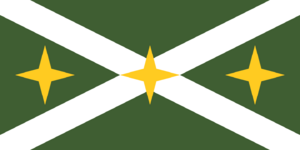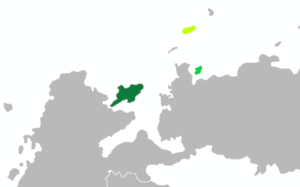User:Kir/Sandbox3
| "Old Dominion" (Working title) |
|---|
‣ New unified concept for Suderawjö & Scapa
‣ t. Urcea pro: Why aren’t Suderavia and Scapa a single dude South Kilikas Federation or some shit ‣ Have them be some ur Coscivians and very early raider arrivals or some shit ‣ Not just a Kiravian colony but true Federacy ‣ the general idea was something like coscivian "North Oldlands Federation" which sits in the higher order of the kravian federalist classes; these people share a language isolate most similar to Great Kiravic Coscivians, over time making it clear to most people that they're descended from the same pre-iceberg proto-coscivian and thus are "Old" Coscivians or whatever. due to their geographic position managed to remain distinct from gothic and gaelic neighbors, though incorporating more """normal""" tendencies by cultural exchange from both. their distinctiveness only really became apparent when Kiravia became a major maritime power and trader and left isolation ‣ reuniting scapaand suderavia with great kiravia became early obsession, first proto-nationalist thing in region, and also very earliest example of kiravian thalassocracy. eventually local suderavian lord conquered scapa and defeated proto fanerians with kiravian assistance (medieval?) and established some sort of subordinate fief ‣ Should have a popular local party called the Anti-Levantine Union Party |
East Kilikas Federacy
| East Kilikas Federacy Érthikilikatix Rektārka | |
 Flag | |

| |
| Suderavia in dark green, Scapa in medium green, Wintergen (disputed) in lime. | |
| Country | |
| Theme | |
| Capital | Xromîda |
| Largest City | Keremonta |
| Population | 5,284,000 |
| Doge | Vanner Kexolm (ALUP) |
| Prime Secretary | Kormákur Felaxriv (ALUP) |
| Legislature | House of Keys |
| Stanora seats | 4 |
| Official languages | Suderavian Coscivian Scapalline Coscivian |
| Recognised languages | Fhasen Kiravic Coscivian Mainland Coscivian |
| Postal Abbreviation | SUD, SKP |
| Time Zone | West Levantine Time Central Levantine Time |
The East Kilikas Federacy (Érthikilikatix Rektārka), also known as the Redeemed Bailiwicks (Ādpasimdix Deneþurguya) is an overseas region of the Kiravian Federacy comprising the peninsular province of Suderavia and the island province of Scapa, both located along the northern coast of Levantia on the Kilikas Sea. The island of Wintergen, internationally recognised as an overseas province of Burgundie, is also part of the claimed territory of the East Kilikas Federacy. Along with Ilánova, with which it has strong historic ties, the lands of the Redeemed Bailiwicks are considered one of the cradles of Coscivian civilisation.
Geography
The East Kilikas Federacy comprises three discrete territorial units located in extreme northern Levantia, each of which is regarded as a province. Suderavia is a peninsula protruding from the Levantine mainland, sharing a land border with Covina at the Isthmus of Sarávak. Scapa is an island off the north coast of Faneria. Wintergen is located in the Archoibh Islands chain between its two sister islands, Lorem and Ipsum, which belong to Faneria. All parts of the East Kilikas Federacy, as their collective name suggests, are in or on the eastern Kilikas Sea.
Climatic conditions vary somewhat across the three dispersed territorial components of the EKF; however they can be broadly categorised as subpolar oceanic or, in bioclimatic terms, occupying positions on the spectrum between hemiboreal to mesoboreal thermotypes and humid to hyperhumid ombrotypes. In layman's terms, weather throughout the Federacy can be described as cold and miserable.
History
From prehistory up to the present day, Suderavia has been a nexus of the "Kilikas World" (Kilikafarax ékuviúl), a web of persistent and resilient networks of travel, transmission, and exchange linking the coasts of Faneria, Covina, Koskenkorva, Éorsa (Ilánova), and northeastern Great Kirav. A remote and marginal appendage of the Levantian continent though it is, Suderavia's role in this corner of the world has been nothing short of central.[citation needed]
Prehistory
Recently unearthed evidence demonstrates that the wanderings of the archæic homonin species Homo darudensis passed through modern Suderavia at one point, though the duration of its presence is still quite uncertain. Later, the 'Boreli Culture' H. neanderthalensis population would also extend into the Suderavian peninsula before their extinction circa 0.73 million years BC. The earliest anatomically and behaviourally modern human culture to leave a significant archæological mark on the Redeemed Bailiwick lands, specifically Suderavia, was an outlying branch of the Packer Culture, known among scholars as the 'Green Bay Packers' as the densest concentration of Packer artifacts in Suderavia is found around the Keremonta (Ænglish: "Green Bay"). Flint and bone tools fashioned in the Demomappic style recovered from the surrounding seabed attest to the first ventures of the direct ancestors of Great Kiravians into the vicinity, beginning what would prove to be a long history of this.
Around 6750 BC, during the Neolithic, maritime technology introduced to littoral Kiravia by the Ʒ-Q Culture facilitated a series of multidirectional, outbound seaborne migrations by the sophisticated megalith-building culture of Éorsa. Two westward waves or floes of migration carried the Austro-Kiravian and Trans-Kiravian languages to the Kiravian mainland. Migration by easterly routes during the same period appears to have carried a separate branch of the Trans-Kiravian languages back to the northwestern Levantian lands from whence their Ice Age ancestors had come thousands of years earlier, including Suderavia. In addition to their languages, these voyageurs brought with them a knack and propensity for megalithic ritual architecture, and other characteristic cultural adaptations - the rudiments of the proto-ethnic Coscivian identity. Thus begins the history of the Mainland Coscivians. Later in history, groups of Mainland Coscivians would migrate southward into other parts of Levantia, by sea or over the Isthmus of Sarávak, and would come to inhabit various other countries as settled minorities or itinerant peoples.
Connected to the Vandarch trade network via sheltered ports in Penthrav. This connexion remains significant even in modern times, and it began the process of South Levantine cultural influence on the Old Dominion that would continue over the successive centuries and leave a lasting impact.
At some point the trans-Kilikas trade networks break down and/and the RB regions also cease to have anything particularly valuable to offer for long-range trade, becoming very isolated.
H
By this time, the Empire had long been little more than a symbolic legal fiction and the Emperor only a unifying figure in a broad cultural sense (albeit an important figure). There was nothing resembling a feeling of National solidarity between Kiravians and the people of the Old Dominions. Indeed, from an outside perspective, the denizens of these provinces were thought of in terms of local identities only, simply as quirky, isolated seaside peasants ekeing out a living on the fringes of the continent, mostly indistinct from their Fhainn and Covine neighbours.
This changed when...
Sunderance
Like most overseas provinces, Suderavia would remain loyal to the Federalist government during the Kiravian Civil War. Peasant life on the peninsula was harsh, to be sure, but feudalism had never truly taken root in the agriculturally marginal province. The hardy Suderavian husbandmen were attune to the cruelty and caprice of Nature and did not think themselves victims of injustice resoluble by political action. Suderavia did have a proletariat employed in the mining camps, port towns, and coaling stations, and there was indeed an active trade union movement, but historians believe that the unions in Suderavia had actually been generally successful in addressing workers' concerns to their satisfaction and without violent confrontation. To the Constitutional Convention of 1934 AD, Suderavia was alotted two seats, and returned one deputy off the Agrarian list and one off the Whiggamore list.
Suderavia's involvement with the Civil War was minimal until its closing stages as the major eastern ports fell one by one to the Red Army. Initially few (but some) refugees fleeing the mainland arrived on Keremonta's wharves, with most seeking haven on Ilánova or Koskenkorva instead. However, when these islands came under threat from the Socialist forces, Suderavia found itself taking in more and more refugees and playing host to considerable quantities of evacuated Federalist troops, ships, and matériel. With the eventual loss of Koskenkorva, Suderavia was left in an unenviable position: Far from the nearest Federalist stronghold (Eusa) across dangerous waters, far removed from the main body of Federalist forces who were then fighting on Great Kirav's west coast, and much farther still from the Federalist government-in-exile in Sirana. Thanks to the Wrecking of the Fleet by retreating Federalists, the Red Navy could not threaten Suderavia for the time being. However, Suderavia had been incontrovertibly left to fend for itself - and for nearby defenceless Scapa.
[TO BE CONITUED]
On September 9, 1936, Commodore Palteran III Leonoix, Prime Commissioner ("Commish") Kil Kamban of Suderavia, Chief Torcuil McRaven of Scapa, and Kormákur Bonîver - the town drunk of Karharrak and a fourth-generation descendant of Wintergen expellees chosen[by whom?] to represent Wintergen - signed the Karharrak Compact, which established the South Kilikas Federacy as a wartime provisional government to undertake and direct all activities necessary for defence of the three[1] provinces from external aggression in the absence of effective federal authority. The Compact was then ritually presented to a megalithic Emperor statue half-buried in the woods outside of town for approval.
In 1941, the Kiravian Remnant concluded an agreement with the Ardmori Republic to lease the land on two of the latter's islands for use as military airfields in order to help maintain flights to Suderavia and Scapa, reëstablishing a reliable logistical line between the South Kilikas Federacy and the Remnant.
[Suderavian Missile Crisis]
Once the Remnant acquired long-range/intercontinental ballistic missile capabilities, it set some of those bad boys up on Suderavia and aimed them right at Kartika. The Kiravian Union was, in the words of People's Rocket Force Captain Karl Levi Åbvius, "not amused". This precipitated a deeply unsatisfying international passive-aggressive bitchfest in which no one got nuked in the end.
Post-Reunification
In the decades since Kiravian reunification, Suderavia's growth and development trajectory has been reliably positive. Unlike many (most) parts of the former Remnant, Suderavia did not experience an economic downturn as a result of reunification, as it had not really gained a position in the Remnant's internal market and production chains that it stood to lose, nor was its economy especially dependent on defence activities and expenditure.[2]
Driznaft: Kiravians in the Crusades
| Notes |
|---|
| ‣ Melians and Sydona are key ‣ Need to coørdinate with Banglazesh ‣ t. Urcea pro: ‣ i think you're actually best positioned for crusades to naturally lead into kiravian empire abroad loose coscivians would be all over crusading coscivian crusader states everywhere the states continue to exist just sort of due to lack of opposition and inertia until ideas about like Great Coscivia and political unity of these places comes about later granted a crusader state surviving until the 17th century at earliest is a long time are there any analogous pre nationalism movements like this? would be worth researching ‣ the less fun but more plausible option ends up being like Coscivian noble families in these places keep dying out, causing more and more distant relations to be more or less forced to assume them overseas while being increasingly more poor and irrelevant, such that you end up having prosperous Kiravians basically passing up foreign thrones and in many cases they just end up being bequeathed to the kiravian state whch i think would bebest for the melians as the crusader state par excellence unless you have something in mind for them ‣ Some form of escheat where heirless lands and titles revert to His Marbliness |
Kiravian crusaders came mainly from South Kirav, the Baylands, and Farravonia. [What polities controlled these lands during this period, and who ruled them/led or sponsored the Crusades from there?]